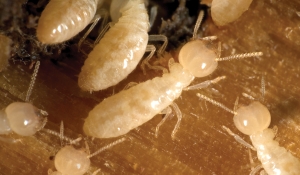Termites in forestry
Termites can have a significant impact on plantation and urban forestry, as well as on agricultural tree crops. Many other insect pest species cause damage to various parts of the tree, but often do not cause mortality. Even where termites do not cause death of the tree, they may cause damage to the bole, for example, by consuming the heartwood and, thereby, hollowing the trunk and reducing the value of the tree as a source of timber. There are a number of current chemical control methods employe d, namely fipronil; imidacloprid; chorfenapyr have proven to be an excellent control product.
d, namely fipronil; imidacloprid; chorfenapyr have proven to be an excellent control product.
The newest tools in fighting termites are products that cause colony mortality away from the treatment site. To be effective, these products must be non-repellent and slow-acting enough to allow intoxicated termites to leave the treatment site. This is important, because large numbers of dead termites around the treatment zone repel healthy termites. Fipronil and imidacloprid kill insects through hyperexcitation of the central nervous system. Fipronil and imidacloprid are both non-repellent, slow-acting insecticides, this delayed behavioral affect may allow healthy nestmates to come in contact with insecticide-treated termites more often. This increases horizontal transmission of slow-acting-insecticide, thus increasing colony mortality.
Alternatively, one may opt for biopesticide such as Phyto-E.

Aquilaria tree damage by Termites
Soil treatment
Soil treatment to protect trees from attack by termites involves the application of chemicals to the soil surrounding the base of the tree. This may be done at the time of transplanting seedlings from the nurseries into the field, or it can be done to trees already in-ground. In the former, granular formulations of insecticides (e.g. fipronil, carbosulfan) are usually used, since they are easy to carry into the field, and they are applied into the planting hole. In the latter, the soil at the base of the tree is removed to form a cavity or trench around the tree, and liquid-based chemicals are poured in and allowed to seep into the ground by gravity and capillary action. The cavity or trench is then filled over with the soil originally excavated from around the tree, and treated as well.














